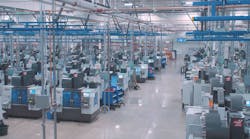Tackling the Zombies, and Other Industry 4.0 Adventures
Digital transformation through Industry 4.0 will inevitably affect all of us. The race to automate and implement artificial intelligence is on. Heightened consumer expectations for innovation and sustainability, combined with recent supply chain disruptions, are leading the way to the next revolution in manufacturing.
First, let’s explore the reasons accelerating the migration to the Fourth Industrial Revolution. Then we’ll take a closer look at Protolabs’ own journey to digital transformation in its manufacturing processes and systems integration.
1. Consumers want more choices. The demand for innovation has never been greater. More consumers are in search of an experience that is uniquely theirs. With that, there is greater urgency to bring more products to market quickly, resulting in a wider variety of produced goods and SKU proliferation. The rise of a digital thread connecting the entire manufacturing process, powered by Industry 4.0 technologies, allows aware manufacturers to adapt to shorter product lifecycles and meet the demands of today, not six months ago.
2. More customers are expecting companies to commit to sustainability. We are seeing our largest brands prioritize ESG (environmental, social, and governance) initiatives. This is impacting how they develop products: A recent survey of 200 executives and engineers found nearly 90% of those companies have adapted product design in the last two years to become more sustainable.
This often comes down to digital tools removing the inefficiencies inherent in bringing a product to market and getting it on shelves. For example, AI can identify design for manufacturability (DFM) issues before they hit the production floor. Industrial Internet of Things (IIoT) technology can automate manufacturing processes that remove waste, offering a pathway to sustainability.
3. “Black swan” events revealed inadequacies in our nation’s supply chain strategy. The COVID-19 pandemic certainly made that clear, with disruptions that had hospital staff wearing minimal PPE and begging for ventilators. Manufacturers have implemented 4IR technologies to create supply chain agility with the ability to operate in quick-turn fashion.
So we know where we have to go, but how do we get there?
While potential applications for 4IR technologies are clear, implementation of increased automation and AI is difficult. The World Economic Forum’s Global Lighthouse Network, which recognizes companies on the forefront of the latest industrial revolution, found more than 70% of companies are stuck in “pilot purgatory” when it comes to the adoption of these technologies.
Tackling the Zombies
Even as a digital manufacturer that has a head start on embracing automation and AI, at Protolabs we know just how difficult this transition is. We recently completed one of the largest projects in the more than 20-year history of our company when we updated our e-commerce platform and revamped the entire digital thread that connects it to the manufacturing floor. In the end, it required more than 400 employees, taking more than four years to complete. It’s safe to say our own journey to the 4th Industrial Revolution was arduous, but one we are all incredibly proud to have conquered.
The transformation was rooted in replacing two decades worth of code intertwined through every facet of our digital manufacturing operation. As you might expect, one of our biggest hurdles was developing the project management process needed to tackle this mammoth endeavor.
For example, how do we tackle the zombies? Those recurring issues only solved with a trade-off that required senior leadership sign-off. We appointed an experienced project manager to monitor the collaborative work streams and serve as a conduit to a Core Leadership Team comprised of executive leaders. The role was vital in identifying the issues and providing clear communication to the leadership team, ensuring we came to the right solution. The project manager was also tasked with creating the processes that ensured employees brought into a task needed to be there. Before each process was launched with a larger group, it was piloted with a smaller group to ensure we were looking at the task from the right angles.
Realizing Full Potential
These efforts were vital in fueling our transformation from a prototype provider to a full production provider via implementation of 4IR technologies. Our founding on a digital front-end allowed for a customer CAD model to be sent over the internet to drive our automated toolpath. However, we had an opportunity to increase the data we received from our network of mills and presses, and our metrology and quality practices were manual, leading to process variations depending on the operator.
Our transformation in building the end-to-end connection—the aforementioned digital thread—enabled us as a technology-driven manufacturer to provide production and prototype parts in as fast as one day. Strategic implementation of automation allowed us to reduce our manual processes—helping both our company and our consumers. Now, accurate design-for-manufacturability (DFM) analysis performed on an auto-created digital twin is delivered to the customer in hours. “G-code” or programming takes place automatically before it is sent to the production floor, eliminating the need for manual operation. Digital process controls ensure repeatability and a digital inspection powered by an auto-programmed coordinate measurement machine is performed in hours versus days. That automation drives significant consumer value in terms of product innovation, speed to market, supply chain risk reduction and more.
Our injection molding facility in Plymouth, Minn., provides an example of these benefits. Recently inducted into the Global Lighthouse Network, we realized a revenue increase of more than $18 million from 2018-2020, along with a 98% quote accuracy through the creation of a digital twin and automated DFM analysis, a 31% reduction in labor costs with automated toolpathing reducing our reliance on labor, and an 80% drop in scrap overrun thanks to digital process controls ensuring repeatability.
With that, our digital transformation is far from complete—in fact, it never really ends because the advancements in our industry continue to identify new opportunities to improve. For example, 4IR technologies have opened the opportunity for us to explore using cobots to improve efficiency on the manufacturing floor.
To be clear, this wasn’t an opportunity to pat ourselves on the back, but rather provide a real-world example that speaks to the value of making the leap to the Fourth Industrial Revolution. Our long, winding, and often barrier-filled journey to adoption will not only makes us better for our consumers, but also is vital to our long-term success as a manufacturing partner.
Mike Kenison is general manager and vice president of Americas, Protolabs.




